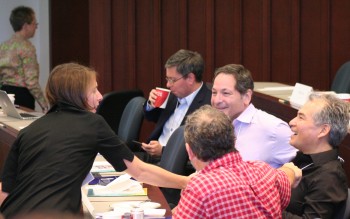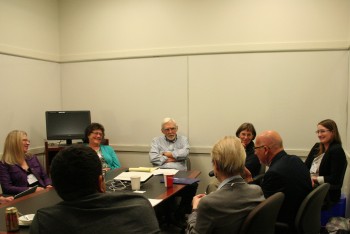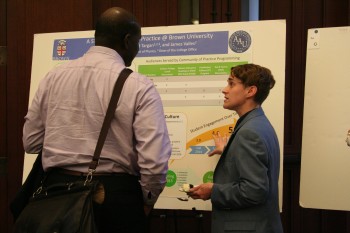More than 100 faculty from 36 AAU-member universities convened at Washington University October 13-14, 2015 to discuss innovations in undergraduate STEM education at the AAU Undergraduate STEM Education Initiative Network Conference.
The two-day event co-sponsored by AAU and CIRCLE, provided opportunities for dialogue among STEM faculty, faculty developers, AAU program directors, and university leaders.
Following the Framework
 Presentations and roundtable discussions followed the AAU STEM Education Initiative framework, which focuses on three elements essential for sustained systemic change in teaching and learning:
Presentations and roundtable discussions followed the AAU STEM Education Initiative framework, which focuses on three elements essential for sustained systemic change in teaching and learning:
- Pedagogy (the core): Articulated learning goals, evidence-based practices, student-learning assessments, inclusive access to STEM education
- Scaffolding (supports Pedagogy): Faculty professional development, program evaluation, conducive classrooms for active-learning pedagogies
- Cultural Change (supports all of the above): Leadership commitment, measures and incentives for teaching excellence
Building a Movement
Washington University Provost Holden Thorp opened the conference. In his welcoming remarks, he noted, “We have a lot of work to do in science education,” and gave a broad view of the importance of active-learning pedagogies. He invited conference participants to ask him questions about transforming STEM education at the institutional level. Noting that he wouldn’t have imagined a STEM conference like this 10 years ago, Thorp celebrated the event, saying “We are building a movement that is going to succeed and make science education more equitable.”
Collaborating for Change
 Faculty and faculty developers presented on various topics, including curricular transformation and project-based learning, active-learning spaces and teaching centers, and new faculty positions that can encourage culture change.
Faculty and faculty developers presented on various topics, including curricular transformation and project-based learning, active-learning spaces and teaching centers, and new faculty positions that can encourage culture change.
Roundtables offered faculty the chance to talk about their experiences so far in transforming their classrooms and departments. Each group collaborated on developing ideas that could be implemented in their courses and created just-in-time posters to display for other groups. Areas of focus included how to learn, scale, and sustain new pedagogical practices, how to collect and share data on program performance, and other questions on how to make systemic changes.
 A poster session on the first evening provided more opportunities to learn from one another as faculty reported on innovations underway in their STEM courses and departments. Topics ranged from designing authentic field research experiences in the biosciences to integrating teaching fellows into courses to catalyze change.
A poster session on the first evening provided more opportunities to learn from one another as faculty reported on innovations underway in their STEM courses and departments. Topics ranged from designing authentic field research experiences in the biosciences to integrating teaching fellows into courses to catalyze change.
The final day of the conference opened with workshops that provided time for focused conversation on measuring progress. Questions in the air included “How do we make data actionable—and create pathways from it towards positive change?” and “Given that research and publishing are easily measured successes, how do we better measure successful teaching in order to cultivate cultures of teaching excellence?”
 Nobel Prize winner Carl Wieman, who holds a joint appointment as Professor of Physics and of the Graduate School of Education at Stanford University, gave the keynote talk on his experience in leading the transformation of teaching approaches across departments at two universities. His talk brought together many of the main threads of the conference, such as fostering faculty interest in change and improving tools for identifying teaching excellence and success in the implementation of active-learning pedagogies.
Nobel Prize winner Carl Wieman, who holds a joint appointment as Professor of Physics and of the Graduate School of Education at Stanford University, gave the keynote talk on his experience in leading the transformation of teaching approaches across departments at two universities. His talk brought together many of the main threads of the conference, such as fostering faculty interest in change and improving tools for identifying teaching excellence and success in the implementation of active-learning pedagogies.
Find out more about the Washington University AAU Undergraduate STEM Education Initiative. See the event website for a full schedule of the day’s talks.
We would like to thank our sponsors, The Luce Foundation and The Teagle Foundation for their generous support that helped make it possible for CIRCLE to host of this conference.